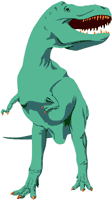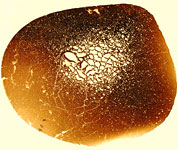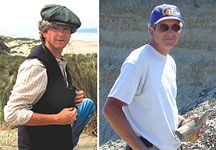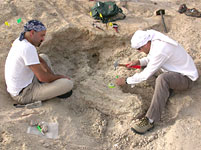
UCMP DINOSAUR-RELATED LINKS
Calendar of dino events at LHS
LHS Big Dinos Return page
This page is designed to add to your BIG DINOS RETURN experience — we’ve pulled together a list of dinosaur-related links that you can visit to learn more about these fascinating, and not-quite-extinct creatures. There is something for everyone here, for young and old, teacher and student. Explore!
An excellent general entry point for U.S. paleontology resources on the internet is The Paleontology Portal. To explore these resources by state, be sure to visit the Exploring Time & Space section!
ON DINOSAURS
 |
Begin a taxonomic tour of the main dinosaur families at The Dinosauria.
DinoBuzz: This page links to articles on often-discussed dinosaur topics, such as dinosaur-bird relations, warm-blooded dinosaurs, dinosaur speed, dinosaur extinction, and dinosaurs in the movies.
A page of miscellaneous links to dinosaur-related subjects on the web.
Get an introduction to the Age of Dinosaurs by learning about the Mesozoic Era and visiting some important Mesozoic fossil localities.
What killed off the dinosaurs? Read an article on the K-T extinction.
Read about some of the earliest dinosaur discoveries in North America.
Find out more about tyrannosaurs in general or about the T. rex that resides here on campus in the atrium of the Valley Life Sciences Building. See a slide show of the building of this T. rex.
Learn more about the dinosaur Dilophosaurus, made famous by the movie Jurassic Park, on this audio tour given by the discoverer of Dilophosaurus, the late Sam Welles.
ON PREPARATION
 Thin slice of Maiasaura leg bone tissue. Photo courtesy of Drew Lee. |
Read a UCMP News article (from January 2001) by preparator Jane Mason about life in the UCMP Prep Lab.
For an easy to understand explanation of bone histology, see the UCMP News article entitled “What’s Inside a Dinosaur Bone?”
ON FLIGHT
Explore vertebrate flight — its origins and evolution, how it works, and the different solutions used by pterosaurs, birds, and bats.
Archaeopteryx is the earliest bird found in the fossil record to date — read more about Archaeopteryx.
ON UCMP PALEONTOLOGISTS
 Kevin Padian (left) observing seabirds; Mark Goodwin holds a Triceratops nasal horn. Padian photo by Jon Blair, courtesy of National Geographic Society; Goodwin photo courtesy of John R. Horner. |
Read more about professor Kevin Padian’s research.
Read more about UCMP assistant director Mark Goodwin’s research. Register online (there will be no on-site registration) for Mark's talk on "The smallest Triceratops skull known: New observations on horned dinosaur growth and behavior." The talk is November 10, at 7:30 PM, at the Lawrence Hall of Science.
TEACHING WITH DINOSAURS
“More than any other science, paleontology can provide opportunities for young students to become involved in learning science.” — Richard Stucky, Denver Museum of Nature & Science
Grade level K-4The Dinosaur Body — Students will recognize that body design affects balance.
Monster Math — Students gain an appreciation of just how big (and small) some dinosaurs and other prehistoric animals were.
Dinosaur Names — Students will use multiple combining forms added to the suffix “-saurus” to form the name of a “dinosaur” which they will then draw.
 Grad students Alan Shabel (left) and Brian Kraatz excavating a fossil. Photo courtesy of Faysal Bibi. |
Correlation and Strata: Findasaurus — Students determine how rock layers correlate based on the presence of index fossils.
Where Can I See the Sea? — Provided with the locations of several kinds of fossils of a given age, students draw a map showing the different paleo-environments present at that time.
Dino-Data — Students are presented with a set of data about dinosaurs and are asked to make hypotheses about what the data can tell us.
Interpreting the Tracks — Students discover the relationships among foot length, leg length, stride length and speed in bipedal animals that provide clues about dinosaur speed.
What Did T. rex Taste Like? — Provides an introduction to cladistics and involves students in posing hypotheses about past life based upon evolutionary history.
The Evolution of Flight — Examines evidence from the fossil record, behavior, biomechanics and cladistic analysis to interpret the sequence of events that led to flight in the dinosaur lineage. Students gather, organize and analyze data and then propose hypotheses about the evolution of flight in birds.
For more great lessons on fossils, geologic time, and evolution, visit these sites:
A wealth of student activities and articles on teaching science through paleontology can be found at Learning from the Fossil Record.
Search for lessons on various topics relating to evolution, such as the History of Life, Natural Selection, and Geologic Time, at the Understanding Evolution website.
Explorations Through Time offers a variety of interactive modules that explore the history of life on Earth, fossils, and evolution.
Student activities and articles for discussion on the nature of science; patterns and processes of evolution; cladistics, phylogenetics, and speciation; and geologic time (list compiled for the National Conference on the Teaching of Evolution, October 2000).